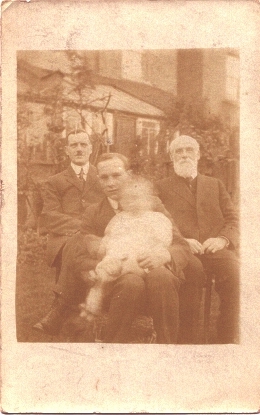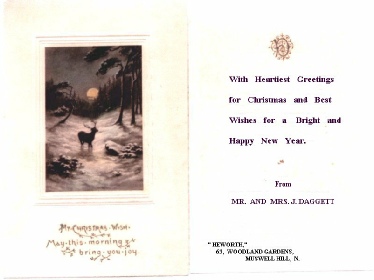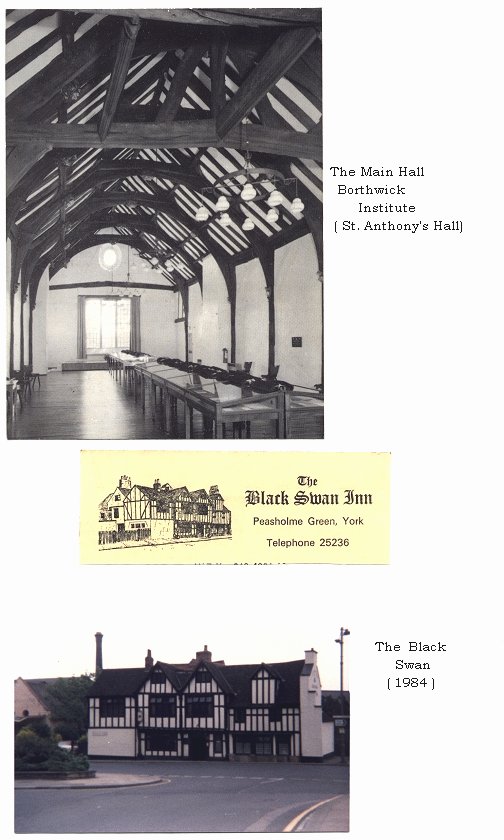Chapter 9.
JOHN (1841-1919)
This was a period of great change for our family because it saw its transfer from Yorkshire to London.
The single name John was bestowed on the first child of Thomas William I and Alice, born at Garden Place,York, in the parish of St.Saviour on 17th July 1841. Although we have a copy of his birth certificate we cannot find any record of his baptism in the registers of that parish or in the Wesleyan Methodist archives. Since it was common practice to christen children with the names of their grandparents and even of aunts and uncles, it is probable that the name John was taken from his grandfather, John Potter - Alice's father. (Another possibility might involve the mysterious John discussed at the end of the previous chapter and who may have been an uncle of the new baby.)
When our John was only six years old his father left his schoolmaster's job in York and went to live in Leeds. It is supposed that his family accompanied him. Two years later Thomas William died, leaving Alice and her two sons, John age 8 and Jason only 3. They returned to York and on 4th October 1850 John was admitted as a pupil at the Blue Coat School. The School Register describes him as "of St.Michael-le-Belfry" in which parish his mother was now perhaps living. He was sponsored by two York shoemakers, Thomas Clayton and Robert Pears; they may have known John's grandfather, William the cordwainer.
The 1851 Census lists John as a scholar at the Blue Coat School but this does not necessarily mean that he was a boarder there. The School was founded in 1705 for 40 poor boys. It was supported by general subscription. A City of York directory of 1843 notes that the number of pupils had grown to 60, and by 1849 there were 70, taught, fed and clothed. The age of entry was usually nine, and at fourteen the boys left to enter a trade, many of them taking up an apprenticeship.
John's stay was longer than the average because he did not leave until he was 18, to become "Assistant Master at the Blue Coat School,Chester". Strangely, part of the column headed "Remarks" against John's name in the School Register has been carefully cut out. After 1860 very few such remarks were entered. During his time the master was William Etches. The salaries of the Master and the Matron amounted to £150 a year, and the Assistant Master got only £30. (Of passing interest is the fact that there were many Hebdens in York at that time, William and Bryan being listed as benefactors of the School from 1823 to 1840.) Some of the earlier comments inserted against pupils' names include :
" a simple-minded boy of tolerable industry"
" a somewhat idle and shifty fellow"
" a bad boy without any redeeming quality"
" tolerably behaved at School, but far from it soon afterwards"
" servant with - - Behaviour good"
" apprenticed to - - " (A very common entry)
" went with his mother to some friends at Bradford"
The Blue Coat School was housed in St.Anthony's Hall, a stone structure on the corner of Aldwark and Peasholme Green, opposite the Black Swan. It is largely unspoilt even today and it now is the home of the Borthwick Institute of Historical Research, a department of York University. The Archives contain most of the ecclesiastical records of parishes in the Diocese of York as well as hundreds of other documents of the greatest interest to the genealogist. We have been privileged to spend many days there during the past few years in our search for details of the past members of our family.
The building of St.Anthony's Hall was started as long ago as 1446 as a Guild Chapel. The stone comes from Tadcaster, the famous brewery town a few miles west of York. Since then the Hall has served many purposes. In 1640 it was a storehouse for the Battle of Marston Moor. A few years later it became a "house of correction" and in 1705 the Blue Coat School was founded for boys aged 7-12, orphans or the sons of poor Freemen of York. It continued to be occupied by this school until 1946. It was opened as the Borthwick Institute in 1953 and ten years later became part of York University as a centre for post-graduate research. A photograph shows part in use as a classroom, with the ancient timber roof, in 1900. The table, still there today, may be 400 years old. As a pupil John Daggett must have been very familiar with the whole of this building and its pleasant garden away from the noise of traffic in the busy road outside. He probably took his lessons in the old classrooms and it is rather more than a coincidence that we have also made good use of the facilities offered in the same building.
The Black Swan, formerly a private house, was built in medieval times before the reign of Elizabeth I. We have enjoyed many a meal there and on some of the colder days during our summer visits have welcomed the blazing log fire in the bar. However, in 1985 there has been some dispute with the local authorities because the inn was included in a "smokeless zone", where wood burning can be frowned upon!
There do not seem to be any records extant concerning the Chester Blue Coat School, so we know nothing about John's employment there as an assistant master. The next we hear of him is his appearance in London, where he got married in September 1866. His address was 323 Grays Inn Road, at the northern end of the street and, perhaps significantly, only a few yards from King's Cross and St.Pancras Stations. He was 25 when he married Ellen Ann Bennett at St.Jude's Church, St.Pancras. Her father's name was Robert, he was a warehouseman, and the marriage certificate was witnessed by Henry Robert Bennett and Elizabeth Manby Bennett. Ellen's address was the same as John's and his occupation was given as "telegraphist".
John and Ellen had ten children, all of whom survived for many years; this contrasts vividly with some of the earlier families where most of the children died in infancy. There were six girls and four boys. The third, Thomas William III, is the one who directly concerns us (he was my grandfather) and so will form the subject of the next chapter.
Now, if we were to buy copies of the birth certificates of all these children we would have a catalogue of the addresses at which they were born, their father's occupation at the time and other interesting details. But such certificates cost £5 each (1984) and so this method of tracing their movements would be very expensive. However, the indexes to Births, Marriages and Deaths since 1837- to be found in the General Register Office - provide us with the name of the District in which each event was recorded. From this we find that our family lived initially in St.Pancras in 1866, moving to Mile End the following year. By 1870 they were in Hackney and remained there until at least 1885, when Beatrice was born.
In 1873 John's job was that of Post Office Clerk* and from 1892 to 1906 he was Head Postmaster at Bedford. His offspring remained in London to carry on their independent lives. In 1873, when Thomas William III was born, the family's address was 11 Albert Street, South Hackney. This street was renamed Warneford St. in 1878 and is a small turning between Mare Street and Victoria Park Road. Victoria Park had been dedicated to the public early in the 1840's, and the parish of South Hackney had been instituted in 1831. In 1860 the railway from Liverpool Street via Hackney Downs to Enfield and Chingford was started and the horse-bus was a popular means of transport. In 1870 a horse-tram service was inaugurated along Bow Road - "to the utter astonishment of the inhabitants", and this was followed by further routes through Hackney in the early seventies.
A local directory for 1872 gives John's home address as 11 Edwin's Terrace, Hackney. Some time before 1914 he moved with some of his family to 63 Woodland Gardens, Muswell Hill near Highgate Wood. An undated Christmas card quotes the name of this house as "Heworth". We do not know whether this name was John's choice, but there is a similarly named place just outside York City, to the north-east. The only other occurrence is near Gateshead.
John died at Woodland Gardens on l9th December 1919 age 78. There is surviving a very faded photograph showing John with his son Thomas William, his son Wilfred John and the infant Wilfred Francis, taken about mid-1918 and embracing four generations!
Ellen Ann remained at Woodland Gardens for a further 12 years. She was 88 when she died in 1931.
John's younger brother, Jason was born on 25th September 1846 at Garden Place, York. We have not attempted to trace his life and progeny in any detail, but we do know that he married Elizabeth Barker in Manchester Cathedral on 25th November 1870. He founded a branch of the Daggett family that remained in the Manchester area until the present time. Jason died towards the end of 1914 at Chorlton, age 68.
* Before moving to Bedford in
April 1892 John had been organist
and choirmaster at South Hackney Church.


“ Four Generations of DAGGETT’S”
John - Thomas William - Wilfred John - Wilfred Francis
1841-1919 1873 - 1955 1892 - 1966 1917 - 2015



